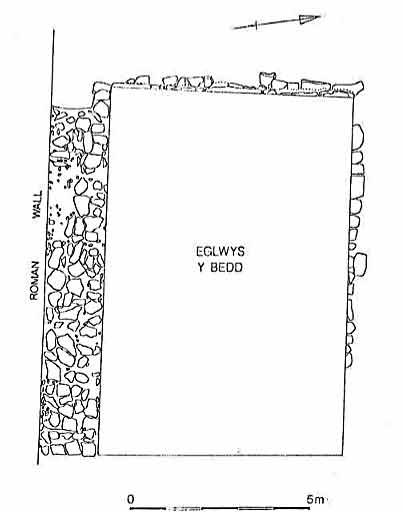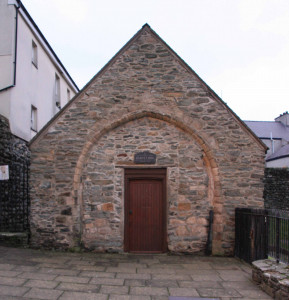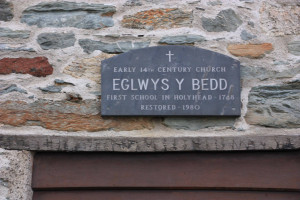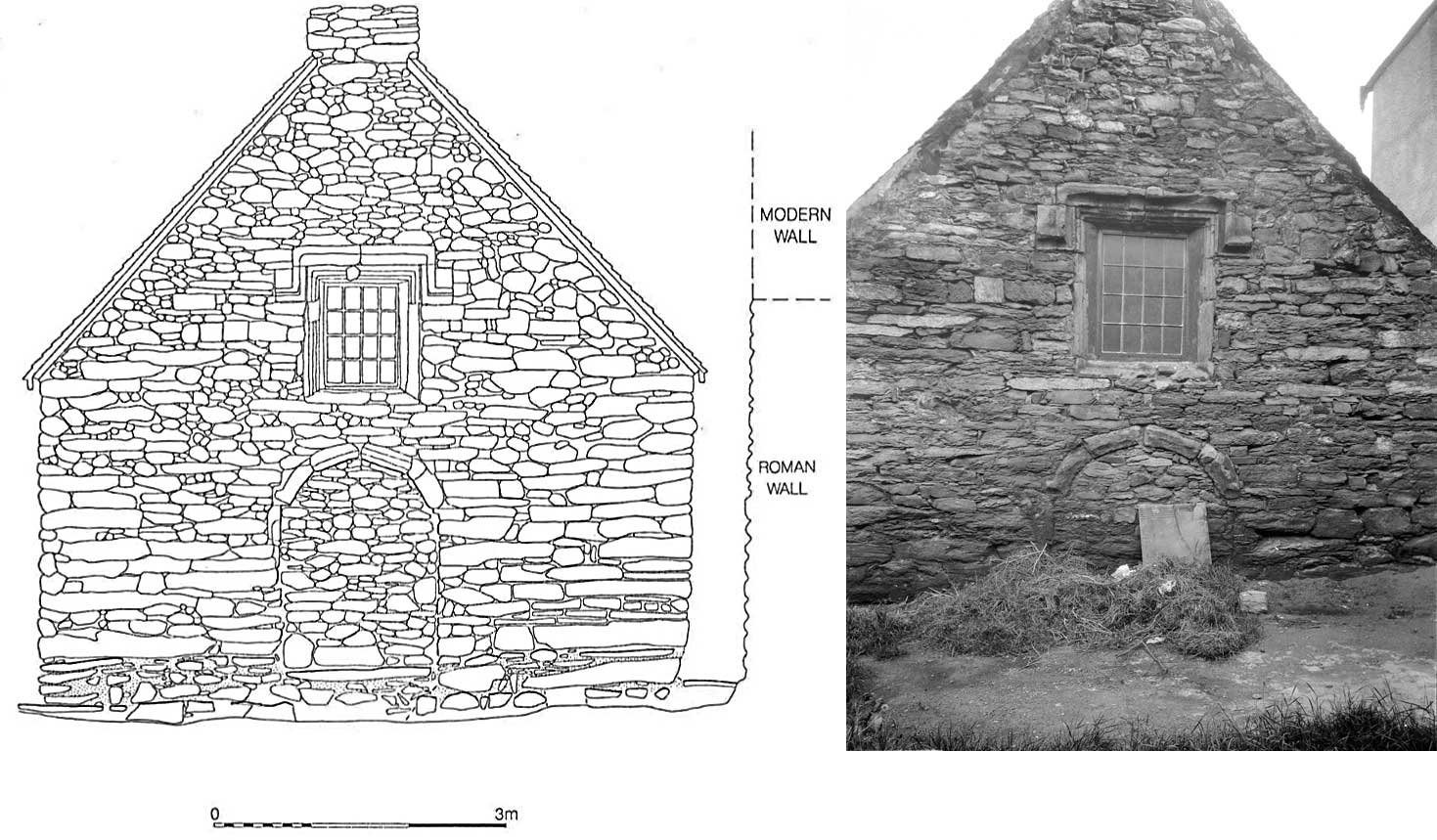Currently Eglwys y Bedd (Chapel of the Grave), which is a Grade II listed building, is used as a meeting room, a choir vestry, and a place to share a cup of tea or coffee after services in church. It is situated in the south west corner of the churchyard, close to the Roman wall.
There is reference to this part of the churchyard first being used as a shrine to the defeated Irish warrior leader Seirgi, who was buried in the churchyard after the battle of Cerrig y Gwyddyl in about 450 AD, and also the shrine of St Cybi. Whilst the alternative name of Capel Llan-y-Gwyddel is now rarely, if at all, used, this description, which translates as Chapel of the Irishman, is clearly a reference to the tradition of Seirgi’s burial here.
The present stone building dates from the fourteenth century and was originally a chapel, with a chancel which was at the eastern end of the present structure. The last ruins of the chancel were cleared in 1810. There is a blocked in fourteenth century chancel arch in the east wall and the west wall has a mutilated two light window, probably fourteenth century, above the head of a fifteenth-sixteenth century doorway.
It has been suggested the building could have been part of the college associated to the church.
According to the unattributed author of the pamphlet about the church and the 1879 address by Dean Stanley“it appears from leases of the collegiate church, that this chapel was endowed with distinct revenues in the reign of Edward III”. [1327 – 1377]
The 1879 pamphlet also refers to the finding of Sirigi’s bones saying “Some of the ruins were removed in the last century to render the entrance to the present church more convenient, and in digging, a stone coffin was found under an arch on the north side of the chancel, containing bones of a large size, and this probably was the shrine of Sirigi, who was canonized by the Irish. According to an old chronicle, they carried off his body and deposited it in their cathedral in Dublin; but the finding of the coffin with gigantic bones seems to render this part of the story improbable.” Here the author appears, wrongly, to interpret the removal of the bones to Ireland as happening at the time of his death, rather than at the time of the discovery of the bones.
The history point for the building says of Sirigi:
The death of Sirigi (or Serigi) was momentous for the Welsh. Anglesey had been invaded by Irish people after the Romans’ departure from Britain. The Irish dominated the island for generations, and the former Roman fort at Holyhead provided a stronghold for a group led by a “giant” called Sirigi. He was eventually killed by Caswallon Law Hir (Caswallon of the Long Hand), who went on to rule Anglesey. The defeat inspired the Welsh to rout Irish settlers from other areas of Wales.
In 1743 Thomas Ellis began collecting funds for Holyhead’s first free school to be held in Eglwys Y Bedd, which was in ruinous condition. He started tapping Chancellor Edward Wynne, Chancellor of Hereford Cathedral and brother of Ann Owen of Penrhos, for funds towards the restoration, and regular reports were sent to the Chancellor of how the money was being spent.
By October of 1746, the walls had been plastered, but the building had no roof, and the large window was unglazed. By September 1744, the roof was in place, and a large oak table for the school was purchased. He did not have any funds to run the school and so in 1746 wrote to Ann Owen to ask if her brother the Chancellor would be offended by a volunteer Master being put in the school for the time being.
The building stood empty until 1748, when the jubilant Ellis wrote in the Parish Register that “Dr. Edward Wynne of Boderwyd gave by a Bond dated November 25th 1748, the sum of six score pounds sterling, towards the endowment of the school in the Churchyard of this Parish. The interest of the said money is to be paid ye Schoolmaster yearly (excepting what goes to the repair of the school) on ye 24th day of November for instructing six poor boys of the parish”. The boys were taught to read, write and cast accounts by John Edwards of Bangor.
In 1992 as part of the Welsh Development Agency’s Town Improvement Grant scheme, an environmental upgrading / consolidation project was proposed for St. Cybi’s churchyard and in anticipation of this Gwynedd Archaeological Trust maintained a watching brief on work carried out on the ground around Eglwys y Bedd.
This work included lowering the soil level around Eglwys y Bedd and building a retaining wall to prevent the soil level returning to its previous level.
Trenches were dug along the north, west and south walls of the building.
A detailed report was prepared and published. This revealed there was stone paving between the south wall of Eglwys y Bedd and the Roman wall.The paving, laid all the way along this corridor, was butted against both the south wall of Eglwys Y Bedd and the south wall of the fort. It was clear, therefore, that the paving could not have been constructed prior to the construction of the fort nor Eglwys Y Bedd. Further examination towards the west end of the corridor revealed that a second course of paving lay underneath. It was decided to remove part of the upper paving on this side in order to ascertain whether the lower course was similarly butted against the fort and church walls, or whether any lower paving stones ran underneath the south wall of the church. It was consequently proved that the lower paving was similarly butted against the church and fort walls. The trench was extended 0.5m to further understand the relationship between the two courses of paving. Examination of this west section revealed no trace of the upper level of paving; however a stone slab clearly related to the lower course of paving was seen protruding out of this section, which was still in its original position.
Along the west wall a rounded depression could be seen directly opposite the blocked doorway. This 2m wide depression was predominantly filled with reddish / brown cinder, and the feature was probably the remains of a heavily trampled path leading towards the doorway in the west wall. Given that the doorway has been dated to the 15th or 16th Century, it may be suggested that the path, was a contemporary feature.
On the north side at a depth of 0.5m they recorded large foundation stones projecting out from the base of the north wall.

Drawing from the 1992 report by Gwynedd Archaeological Trust showing the exposed pavement between Eglwys y Bedd and the Roman wall and the stones projecting from below the existing building.
In their summary Gwynedd Archaeological Trust concluded:
The excavation at St. Cybi’s churchyard succeeded in yielding valuable information probably related to more than one phase of activity at Eglwys Y Bedd. Although not accurately datable, the features encountered at the west and south sides of the church were successfully unravelled into a general stratigraphical sequence.
It was also hoped to retrieve some information related to the Roman occupation of the site, particularly between the south walls of both the fort and Eglwys Y Bedd. The foundations of the fort wall were not reached, and this along with any other features of this period, presumably lay a good deal deeper than the layers of paving that were reached.
The project also demonstrated how the general build up of the churchyard has occurred at such a rapid rate. The discovery of four 19th Century gravestones during the construction of the lighting duct and paths serves to show how many fairly recent gravestones have been gradually hidden from view, several of which are probably unrecorded.


